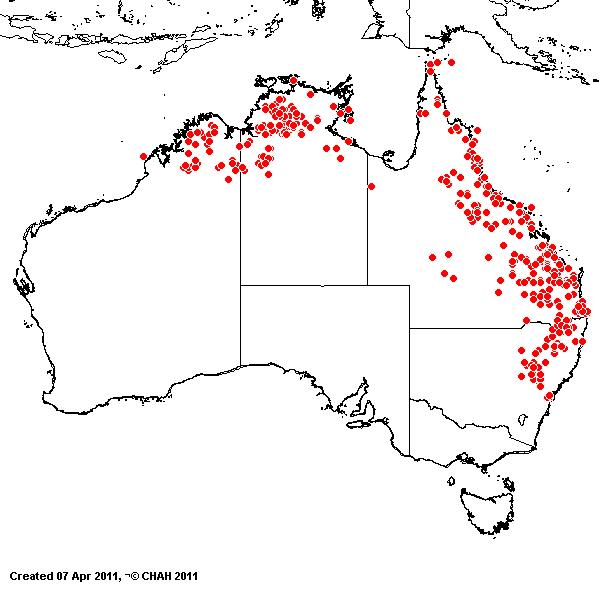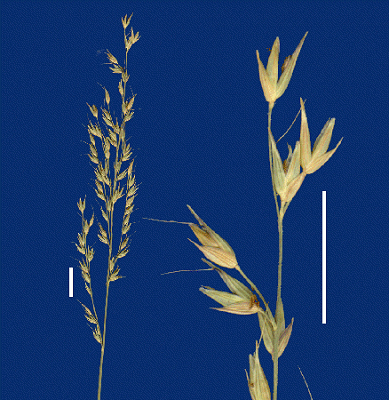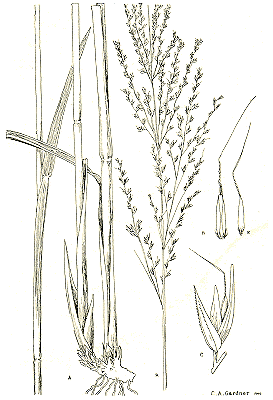Arundinella nepalensis Trin. Gram. Pan. 62 (1826).
Classification. (GPWG 2001) : Subfamily Panicoideae. Arundinelleae.
Type of Basionym or Protologue Information: Nepal:, Wallich s.n. in Herb. Lindley (HT: LE; IT: K).
Key references (books and floras): 1878] G.Bentham, Flora Australiensis 7 (545), [1952] C.A.Gardner, Flora of Western Australia 1 Gramineae (224), [2002] D.Sharp & B.K.Simon, AusGrass, Grasses of Australia, [2008] S.W.L.Jacobs, R.D.B.Walley & D.J.B.Wheeler, Grasses of New South Wales (135).
Illustrations: [1952] C.A.Gardner, Flora of Western Australia 1 Gramineae (223, Pl. 66), [1983] J.C.Tothill & J.B.Hacker, Grasses of Southern Queensland (114), [1984] N.T.Burbidge. rev. S.W.L.Jacobs, Australian Grasses (65), [2008] S.W.L.Jacobs, R.D.B.Whalley & D.J.B.Wheeler, Grasses of New South Wales, 4th edn (135).
Derivation: L. -ense, denoting origin. From Nepal.
Habit. Perennial. Rhizomes present, short. Culms erect, 180 cm tall, 1.5–5 mm diam., 2–5 -noded. Mid-culm nodes pubescent. Lateral branches simple or sparsely branched. Leaves cauline. Leaf-sheaths glabrous on surface. Ligule an eciliate membrane, 1 mm long, truncate. Leaf-blades straight, flat, 8–40 cm long, 3–10 mm wide. Leaf-blade surface glabrous or indumented.
Inflorescence. Inflorescence compound, a panicle. Panicle lanceolate or pyramidal, 5–40 cm long, contracted about primary branches.
Spikelets. Spikelets pedicelled, 2 in the cluster. Fertile spikelets 2-flowered, the lower floret barren (rarely male), the upper fertile, comprising 1 basal sterile florets, comprising 1 fertile floret(s), without rachilla extension, lanceolate, laterally compressed, 4–7 mm long.
Glumes. Glumes dissimilar, thinner than fertile lemma. Lower glume ovate, membranous, keeled, 1-keeled, 3–5 -nerved. Upper glume ovate, membranous, keeled, 1-keeled, 5 -nerved. Florets. Basal sterile florets 1, male, with palea. Lemma of lower sterile floret 100 % of length of spikelet, membranous, 1-keeled, 3–5 -nerved.
Fertile lemma 2–3 mm long, without keel, 3–5 -nerved. Lemma apex dentate or lobed, awned, 1 -awned. Median (principal) awn from a sinus, 4–6 mm long overall, with a twisted column. Palea 2 -nerved. Palea apex dentate. Lodicules present. Anthers 3. Grain 1.6 mm long.
Continental Distribution: Africa, Temperate Asia, Tropical Asia, and Australasia.
Australian Distribution: Western Australia, Northern Territory, Queensland, New South Wales.
Western Australia: Gardner, Fitzgerald, Hall, Dampier. Northern Territory: Darwin & Gulf, Victoria River, Barkly Tableland. Queensland: Burke, Burnett, Cook, Darling Downs, Gregory North, Leichhardt, Maranoa, Mitchell, Moreton, North Kennedy, Port Curtis, South Kennedy, Warrego, Wide Bay. New South Wales: North Coast, Central Coast, Northern Tablelands, North-Western Slopes, Central-Western Slopes, North-Western Plains.
Notes. Tropical Africa, Madagascar, India to China and tropical and subtropical Australia. Savanna woodlands of tropics and subtropics, particularly in wetter areas. Flowers year round.




